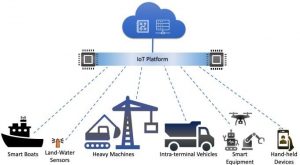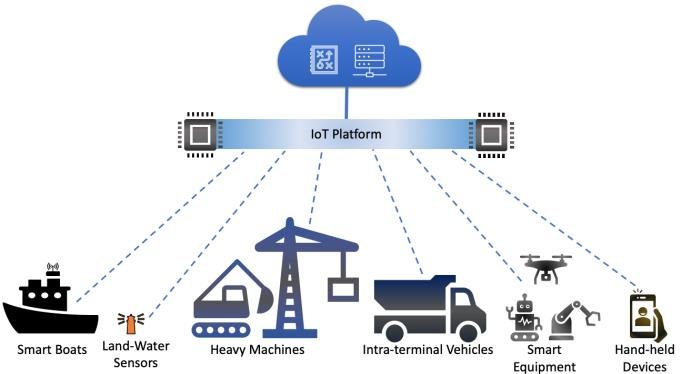The Internet of Things (IoT) has revolutionized various industries, and the port industry is no exception. With the growing need for efficient and sustainable port operations, IoT technology is being increasingly adopted to enhance productivity, safety, and environmental performance. This article will explore the evolution of IoT in the port industry, discuss its challenges and opportunities, and provide insights into future trends.

Evolution of IoT in the Port Industry
- Smart Containers
The adoption of smart containers has transformed cargo monitoring and management in the port industry. These containers are equipped with IoT sensors, enabling them to transmit real-time data on location, temperature, humidity, and other parameters. This data is invaluable in ensuring the safety and security of cargo during transit.
Through continuous monitoring, shipping companies can track their containers’ movements and respond more effectively to any changes in environmental conditions, damage, or theft. In addition, IoT data can facilitate better coordination between different stakeholders, such as shipping lines, port authorities, and customs officials, leading to streamlined cargo handling and reduced dwell times.
- Automated Cranes and Vehicles
IoT technology has enabled the automation of various port operations, including loading and unloading of cargo. By utilizing IoT-enabled equipment such as cranes, straddle carriers, and automated guided vehicles (AGVs), ports can significantly improve their productivity and efficiency. These machines are equipped with sensors that can communicate with each other and central control systems, allowing for better coordination and reduced human intervention.
The automation of cargo handling processes not only speeds up operations but also reduces the risk of accidents and human errors. Moreover, the data generated by these IoT-enabled machines can be used to optimize equipment usage, plan maintenance schedules, and minimize equipment downtime.
- Environmental Monitoring
Sustainability is becoming an increasingly important aspect of port operations, and IoT technology plays a crucial role in helping ports meet their environmental goals. IoT devices are used to monitor various environmental factors, including air and water quality, noise levels, and energy consumption. The data collected by these devices can be used to identify areas for improvement and implement effective measures to reduce the environmental impact of port operations.
For example, IoT sensors can monitor emissions from ships and port equipment, helping ports identify high-emission zones and take necessary actions to reduce pollution. Similarly, sensors can track energy consumption patterns, enabling ports to optimize energy usage and adopt more sustainable practices. By leveraging IoT technology, ports can not only enhance their environmental performance but also comply with increasingly stringent environmental regulations.
In conclusion, the evolution of IoT in the port industry has had a significant impact on various aspects of port operations, from cargo management to automation and environmental monitoring. As the technology continues to advance, the port industry can expect even greater benefits, leading to more efficient, sustainable, and competitive port operations.
Challenges and Opportunities
Challenges:
- Cybersecurity
The increasing connectivity of IoT devices in the port industry poses significant cybersecurity challenges. With vast amounts of sensitive data being transmitted between devices and systems, ports are becoming more vulnerable to cyberattacks, data breaches, and unauthorized access. To mitigate these risks, ports must invest in robust security measures, including encryption, secure authentication protocols, and regular security audits. Additionally, employee training on cybersecurity best practices can help raise awareness of potential threats and ensure that everyone is well-prepared to identify and respond to any security incidents.
- Data Management
The sheer volume of data generated by IoT devices in the port industry can be overwhelming, presenting challenges in data management, processing, storage, and analysis. To address this issue, ports must develop efficient data management strategies that involve employing advanced data analytics tools and leveraging technologies such as cloud computing and edge computing. These solutions can help ports process and analyze vast amounts of data in real-time, enabling them to derive valuable insights and make informed decisions. Moreover, data governance policies must be implemented to ensure data privacy, security, and compliance with relevant regulations.
- Integration
Integrating IoT solutions into existing port infrastructure can be a complex task, especially when dealing with legacy systems. Ports may face difficulties in ensuring seamless interoperability between IoT devices, existing equipment, and software systems. To address this challenge, ports should adopt open standards and platforms that facilitate integration, as well as work closely with IoT solution providers to develop customized integration plans. Moreover, fostering a culture of innovation and collaboration among different stakeholders, such as port authorities, technology providers, and shipping companies, can help overcome integration challenges and drive successful IoT implementations.
Despite challenges, IoT technology offers opportunities for the port industry:
- Enhanced Efficiency
IoT technology offers significant opportunities to improve efficiency in the port industry, resulting in cost savings and increased productivity. By connecting various assets, such as berths, equipment, and labor, IoT enables real-time monitoring and data collection, allowing port operators to optimize their resources and make more informed decisions.
For instance, IoT can help port operators better allocate berths to incoming vessels, taking into account factors like vessel size, cargo type, and estimated time of departure. This optimizes the use of available berths and minimizes idle time, leading to increased throughput.
Similarly, IoT-enabled equipment like automated cranes and vehicles can streamline cargo handling operations. By providing real-time data on container locations and status, IoT technology allows port operators to better coordinate loading and unloading activities, reducing delays and improving overall productivity.
- Predictive Maintenance
Predictive maintenance is another significant opportunity presented by IoT in the port industry. By analyzing data collected from IoT sensors on equipment, such as cranes, trucks, and conveyor systems, port operators can identify potential failures before they become critical.
IoT data can help detect patterns or anomalies that may indicate an impending failure, such as unusual temperature fluctuations, vibrations, or changes in energy consumption. By identifying these issues early, ports can schedule maintenance proactively, reducing downtime and associated costs.
Moreover, predictive maintenance can also extend the lifespan of equipment and minimize the need for costly replacements, further contributing to cost savings and improved operational efficiency.
- Improved Safety and Security
Safety and security are paramount concerns in the port industry, and IoT technology can play a crucial role in enhancing these aspects. Real-time monitoring and tracking of port activities, enabled by IoT devices, can help identify potential hazards, such as equipment malfunctions or unauthorized personnel in restricted areas.
For example, IoT sensors can monitor the structural integrity of cranes, detecting any signs of wear or damage that could lead to accidents. This allows port operators to take preventive measures, such as repairing or replacing the affected components before a failure occurs.
In terms of security, IoT devices can be used for access control, tracking the movement of people and vehicles within port premises. By integrating IoT with video surveillance systems, facial recognition, and other security technologies, ports can effectively monitor and manage access to restricted areas, minimizing the risk of unauthorized entry or theft.
In conclusion, despite the challenges associated with implementing IoT technology in the port industry, the opportunities it presents are numerous and transformative. By leveraging IoT to enhance efficiency, enable predictive maintenance, and improve safety and security, ports can achieve significant cost savings, increased productivity, and better overall performance.
Future Trends in the Port Industry and IoT
- Integration with Other Emerging Technologies
As the port industry continues to adopt IoT, it is expected to integrate with other emerging technologies to create more advanced and efficient port operations. Some of these technologies include:
a. Artificial Intelligence (AI): AI can be used to analyze the massive amounts of data generated by IoT devices, enabling ports to make more informed decisions and automate various processes. For instance, AI can help optimize berth allocation by analyzing historical data, vessel information, and real-time port conditions.
b. Blockchain: Blockchain technology can be used in conjunction with IoT to enhance supply chain visibility and security. By creating a secure, decentralized ledger of transactions, blockchain can facilitate real-time tracking of cargo and streamline customs clearance, reducing delays and improving overall efficiency.
c. 5G Connectivity: The advent of 5G networks will enable faster and more reliable communication between IoT devices, enhancing the efficiency and effectiveness of data transmission in port operations. This will support the development of advanced IoT applications, such as real-time vessel tracking and remote equipment monitoring.
- Data-Driven Decision-Making
As the port industry becomes more reliant on IoT-generated data, data-driven decision-making will play an increasingly crucial role in optimizing operations. Ports will use advanced analytics tools to extract insights from the vast amounts of data generated by IoT devices, helping them make more informed decisions in various areas, including:
a. Berth allocation: By analyzing historical and real-time data on vessel arrivals, departures, and port conditions, ports can optimize berth allocation, improving throughput and reducing idle time.
b. Cargo handling: IoT-generated data can help ports coordinate and streamline cargo handling operations, ensuring efficient loading and unloading processes.
c. Workforce management: IoT data can be used to monitor employee performance and identify areas for improvement, enabling ports to optimize workforce deployment and enhance productivity.
d. Energy consumption: IoT-enabled monitoring of energy usage can help ports identify inefficiencies and implement measures to reduce their environmental impact.
- Smart Ports
The widespread adoption of IoT technology in the port industry will lead to the development of fully automated, interconnected, and sustainable smart ports. These next-generation ports will leverage IoT, AI, blockchain, and other advanced technologies to create seamless and efficient services for shipping lines, cargo owners, and other stakeholders. Key features of smart ports include:
a. Full automation: Smart ports will utilize IoT-enabled equipment and autonomous vehicles to automate key processes, such as cargo handling, container tracking, and customs clearance, reducing human intervention and associated risks.
b. Interconnectivity: IoT devices will facilitate real-time communication and data exchange between different port stakeholders, including terminal operators, shipping lines, and customs authorities, streamlining operations and enhancing collaboration.
c. Sustainability: Smart ports will prioritize environmental sustainability, using IoT devices to monitor and manage energy consumption, emissions, and waste management, in line with global standards and regulations.
In conclusion, the future of the port industry is likely to be shaped by the integration of IoT with other emerging technologies, data-driven decision-making, and the development of smart ports. These trends will drive innovation, enhance efficiency, and promote sustainability in the sector, offering significant benefits to all stakeholders involved.
IoT is transforming the port industry by providing valuable insights and enabling better decision-making, improved operational efficiency, and enhanced sustainability. As the technology continues to evolve, the industry must address the challenges and capitalize on the opportunities IoT presents to stay competitive and drive innovation in the future.
By MaritimEducation team.


Artificial Intelligence: What’s Coming Next?
AI Revolution: What We Should Expect
AI’s Impact on Technological Change
A Comprehensive Guide to Tutorials and Tips for Learning New Skills
thank you very much
very good
+ for the post